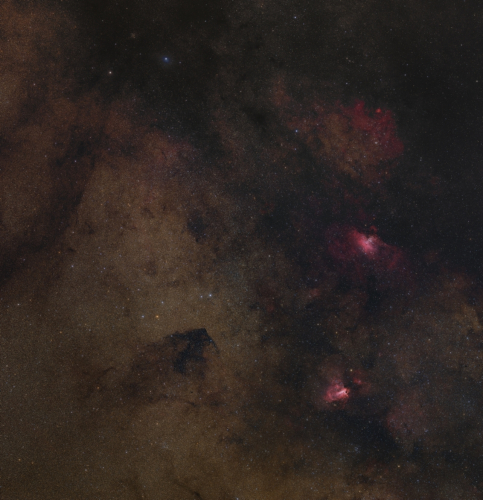

Object data M 16
Object type:
Size:
Magnitude:
Constellation:
Distance:
Notes:

Exposure data
Date:
Location:
Telscope & Camera:
Mount:
Exposure time:
Exposure time total:
Notes:
Ursa Major obs. @ ROSA (remote observatory southern alps)
Vixen FL55SS with flattener + reducer, f = 237 mm
QHY 163 c, gain 25, offset 50
iOptron iEQ35 pro
42x5 min each mosaic part
21 h
data acquired remotely using Voyager by Leonardo Orazi



- CEDIC Team goes Chile II
- CEDIC Team goes La Palma I
- CEDIC Team goes La Palma II
- CEDIC Team goes La Palma III
- CEDIC Team goes Namibia
- Namibia 2022 - Intro
- #1 - Clusters in Carina
- #2 - Hidden Treasures in Vela
- #3 - Southern Galaxies
- #4 - Emission Nebulae in Centaurus
- #5 - Near South Pole
- #6 - Dark Nebulae in Cir & Lup
- #7 - Nebulae in Ara & Norma
- #8 - Nebulae in Scorpius
- #9 - Open Clusters in Scorpius
- #10 - Highlights in Sagittarius
- #11 - Nebulae in Ophiuchus
M 16 / M 17 2x3 mosaic in Serpens / Sagittarius
Open cluster +
emission nebula
Ser
2021-05-31 + 06-03+06+07+08+10+11+13+14+15+16+27+28+30
(14 nights)
7 000 ly
The Eagle Nebula (Messier 16) is a conspicuous region of active
star formation, situated in Serpens Cauda. The starforming nebula,
a giant cloud of interstellar gas and dust, has already created a
considerable cluster of young stars.
The cluster is also referred to as NGC 6611, the nebula as IC 4703.
+ 6.0 mag
35’

Object data M 17
Object type:
Size:
Magnitude:
Constellation:
Distance:
Notes:

Emission nebula
Sgr
5 000 ly
Messier 17 (also known as The Omega Nebula or the The Swan Nebula)
is an emission nebula in constellation Sagittarius. Its distance is
estimated to 5,000 light-years and it spans some 15 light-years
in diameter. The cloud of interstellar matter of which
this nebula is a part is roughly 40 light-years in diameter and
has a mass of 30,000 solar masses. The total mass of the Omega Nebula
is an estimated 800 solar masses. Therefore, Messier 17 is considered
one of the brightest and most massive star-forming regions of our galaxy
+ 6.0 mag
11’

















